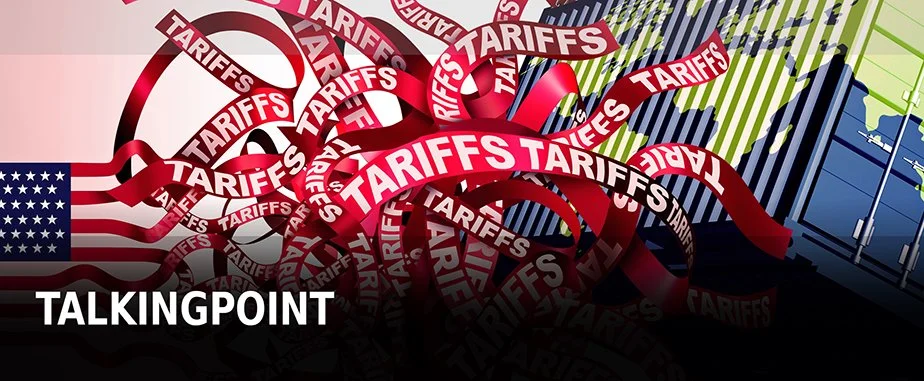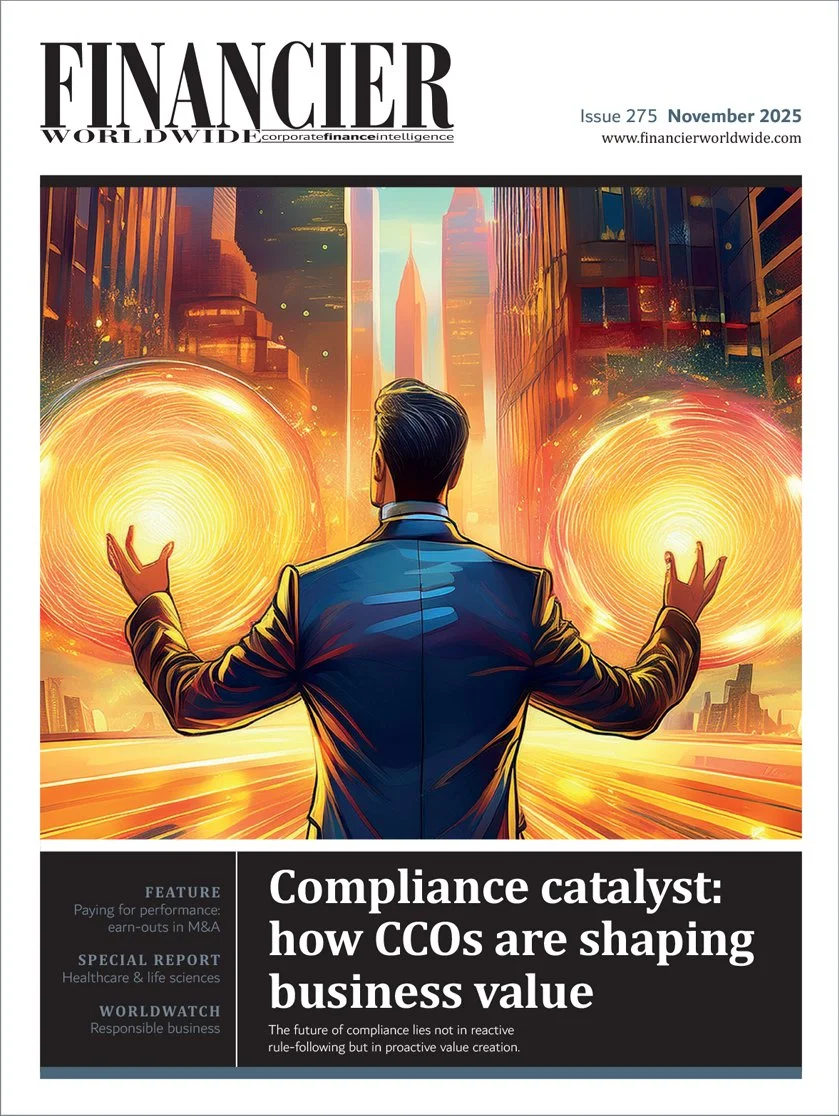Building business resilience: risk management for global tariff volatility
November 2025 | TALKINGPOINT | RISK MANAGEMENT
Financier Worldwide Magazine
FW discusses business resilience and risk management amid global tariff volatility with Mary Rollman, Margret Muzzin, Luca Bonardi, George Zaharatos and Daniel Click at KPMG.
FW: Could you provide an overview of key trends and developments affecting global tariffs?
Zaharatos: Tariffs continue to affect organisations across multiple functions, from supply chain dynamics to tax compliance and financial forecasting abilities. The impact is broad and multifaceted, requiring a thorough assessment to identify areas of vulnerability and opportunities for optimisation. To effectively mitigate risks and maintain operational resilience, organisations have been approaching tariff mitigation along a continuum – react, reposition and restructure. Companies require real-time insights into tariff rates and regulations to make informed decisions along the continuum. Given the complexity of how tariffs are applied, focus has shifted from simple accounting of tariffs applied to one’s own imports, to visibility of tariffs from suppliers seeking to pass-through tariff costs. The sectoral tariffs, or product-based tariffs, including those on steel, aluminium and copper derivative products, complicate requirements for composition and country of origin of component materials suppliers. To reposition supply chains and eventually restructure, sure footing through trade data is key.
“Firms are actively engaged in renegotiating existing contracts by adding tariff trigger clauses and adjusting pricing terms.”
FW: For companies in the US, what lessons have been learned from recent tariff shocks that are now shaping proactive resilience planning? What are the most common blind spots or misconceptions US businesses have when assessing their exposure to global tariff risks?
Rollman: Recent research shows that the tariff shocks in 2025 have driven US companies to bolster supply chain agility, diversify suppliers and increasingly consider nearshoring. The ‘2024 Proximity Premium’ report finds that 60 percent of global firms have begun sourcing materials and components from multiple countries, while 35 percent are actively pursuing nearshoring strategies to reduce exposure to tariffs that impact supply into the US. Changes to supplier relationships are evident, as organisations invest in new partnerships and strengthen their procurement processes and contracts. Common blind spots include underestimating indirect tariff costs – such as increased lead times and logistics hurdles – and relying too heavily on established suppliers without thorough resilience testing. Many US businesses also overlook risks beyond their immediate supply chain, missing vulnerabilities in secondary or tertiary suppliers. To strengthen resilience, there has been an uptick in scenario planning, supplier diversification and strategic relocation of sourcing closer to home, as companies respond to the evolving global trade environment.
“Tariff modelling tools are designed to provide scenario planning analytics and support companies in developing supply chain strategies.”
FW: How are US firms adapting their strategies to mitigate supplier risk of sudden tariff changes, especially in high-exposure sectors like tech and manufacturing?
Click: Many organisations are rationalising their supplier diversification programmes by shifting sourcing to countries with lower tariff exposure or expanding domestic production to reduce or eliminate the exposure of changing tariffs. Firms are actively engaged in renegotiating existing contracts by adding tariff-trigger clauses and adjusting pricing terms. Lastly, compliance officers are working to quickly gain a deeper understanding of not only how tariffs are calculated but also how third parties may exploit current laws and regulations for their own benefit.
“The tariff shock also presents an opportunity to update transfer pricing policies to reflect facts that may have evolved over time.”
FW: In your experience, how effective have companies been at accounting for tariffs and financial planning at the board level in preparing companies for tariff shocks? What metrics or models are proving most useful?
Muzzin: Companies that have been proactive and effective have taken a closer look at the accounting implications in connection with tariff costs. The increased cost pool has required companies to identify and track tariffs at the component part level. This is required to ensure they have captured such costs correctly as inventoriable costs, as well as to ensure that any full absorption models have properly contemplated and incorporated the incremental costs. Increased cost has also put additional scrutiny on customer contracts as importers of record continue to try to pass-through related costs. Models that allow costs to be tracked at the component part level for actual costs incurred are allowing for data to be used not only to support financial accuracy and financial planning in connection with required reporting, but also in providing the visibility and granularity to inform strategic supply chain decisions and commercial negotiations.
FW: How are companies leveraging technology – such as artificial intelligence, predictive analytics and integrated enterprise risk management systems – to improve responsiveness to tariff volatility?
Zaharatos: Through use of data made available by US Customs and Border Protection, known as automated commercial environment data, together with customs broker reports and purchasing order data in internal systems, companies can effectively communicate impacts across their organisation and to multiple stakeholders. Using historical import and export data, they can generate interactive dashboards to analyse trade data, identify areas of risk and begin supply chain scenario planning. Tariff modelling tools are designed to provide scenario planning analytics and support companies in developing supply chain strategies. Artificial intelligence (AI) is revolutionising the way supply chain planning is managed. AI can help collect and summarise regulatory information on tariffs, apply it to transactional data, and support the identification of alternative sourcing strategies. Embedding AI in the supplier tariff validation process accelerates reviews and enriches insights from transactional data.
“The increased cost pool has required companies to identify and track tariffs at the component part level.”
FW: What emerging best practices are you seeing in cross-functional collaboration between finance, tax, legal, procurement, and so on, to build holistic resilience against tariff disruptions?
Bonardi: Tariffs impact all elements of a company’s value chain, from where they source to how they pass cost increases on to customers. The best strategies require a holistic approach and collaboration across key departments, including finance, tax, IT and legal. Most affected companies have established multidisciplinary tariff task forces to model and implement different strategies and mitigation approaches. Such approaches include sourcing from a more favourable country of origin, implementing first sale for export, and revising intercompany policies to separate charges embedded in the transfer price for the product to reduce the dutiable value. The tariff shock also presents an opportunity to update transfer pricing policies to reflect facts that may have evolved over time, such as the increasing role of data and technology, that now create sources of competitive advantage through services beyond the sale of a tangible product.
“Sixty percent of global firms now source materials from multiple countries.”
FW: Looking ahead, what emerging global trade dynamics – such as digital trade, regional blocs and nearshoring – do you believe will most significantly reshape how US businesses manage tariff risk?
Rollman: The ‘2024 Proximity Premium’ report highlights a pronounced shift among US businesses toward mitigating tariff risk by diversifying and nearshoring supplier relationships. Sixty percent of global firms now source materials from multiple countries, while 35 percent actively pursue nearshoring strategies to limit tariff exposure. This proactive approach reduces dependency on single suppliers and bolsters supply chain agility, enabling companies to respond swiftly to trade disruptions. The trend underscores how regional blocs and sourcing closer to home are reshaping enterprise resilience. By expanding supplier networks and investing in robust procurement processes, US businesses are better equipped to manage both direct and indirect tariff risks, remain competitive and sustain growth amid evolving global trade dynamics.
Mary Rollman is a partner at KPMG with 30-plus years of consulting and industry experience, with a specialty in supply chain and operations. Her experience in this space spans a broad spectrum including due diligence and transactions, global expansion, performance improvement and operational excellence, manufacturing and network strategy, operating model design, organisation and talent, and digital and systems. She has worked across pharmaceuticals, biotech, consumer goods, retail, high tech, and oil and gas. She can be contacted on +1 (312) 618 9863 or by email: maryrollman@kpmg.com.
Margret Muzzin is a partner in KPMG’s accounting advisory services within deal advisory & strategy, focused on automotive, automotive technology, transportation and logistics, and industrial market clients. She has over 22 years of technical experience as it relates to buy side, sell side and technical accounting projects. She has experience in both technical accounting and project management for buy side, sell side and technical accounting projects. She also has extensive experience with transactions. She can be contacted on +1 (313) 230 3227 or by email: mmuzzin@kpmg.com.
Luca Bonardi is a principal and brings over 25 years of experience working with a diverse client base on various transfer pricing (TP) issues. He focuses on retail and consumer products clients throughout the east coast of the US. He leads TP studies for multinational corporations, including the preparation of global BEPS-compliant documentation, TP planning to assist companies as they integrate or spin-off their businesses, valuation of intangible assets and optimisation of TP structures. He can be contacted on +1 (973) 912 6306 or by email: lbonardi@kpmg.com.
George Zaharatos is a principal in KPMG’s trade and customs practice and global lead partner for data and technology and co-lead partner for trade & sustainability. He focuses on trade strategy primarily in global automotive and energy supply chains ranging from forced labour risk, carbon tax regulations, tariffs, incentives and US trade controls. He also serves as a board member of the non-profit Atlanta Council on International Relations, coordinating dialogue on business, geopolitics and global trade. He can be contacted on +1 (404) 222 3292 or by email: gzaharatos@kpmg.com.
Daniel Click is a partner in the Detroit, Michigan office of KPMG’s US risk services practice where he specialises in forensic advisory services. He has more than 30 years’ experience building and leading world-class compliance and investigations teams for large, complex organisations and partnering with a variety of stakeholders. He is KPMG’s industrial manufacturing and consumer market industries leader, with substantial experience leading compliance and investigations teams in the industrial manufacturing, automotive and consumer markets industries. He can be contacted on +1 (313) 230 3240 or by email: dclick@kpmg.com.
© Financier Worldwide








